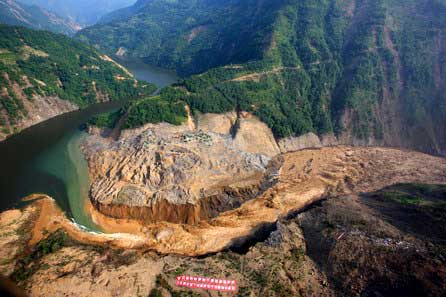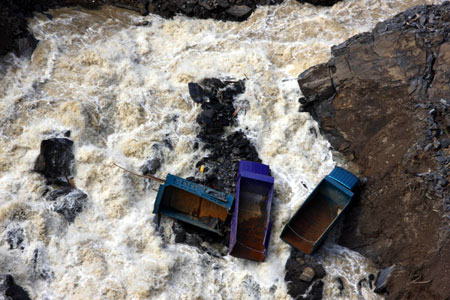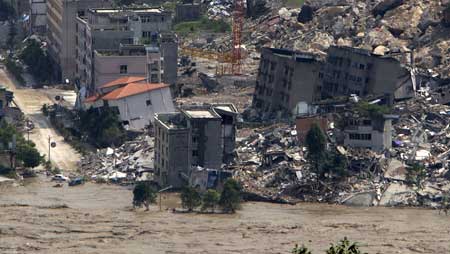Quake lake expected to shrink as drainage speeds up
(Xinhua/China Daily)
Updated: 2008-06-10 06:51
Updated: 2008-06-10 06:51
 Picture taken at 9 am on June 10, 2008 from a military helicopter shows the drainage of the Tangjiashan quake lake in southewest China's Sichuan Province. Drainage of the quake lake through a manmade spillway speeded up to 1,760 cubic meters per second at 9:30 am on Tuesday, whereas water flow in the lower reaches of the lake, in Beichuan County, reached 2,240 cubic meters per second. [Xinhua] |
MIANYANG, Sichuan -- The water level in Tangjiashan quake-formed lake in southwest China's Sichuan Province is expected to fall on Tuesday, as outflow has far outpaced influx three days after drainage efforts began.
Drainage of the quake lake through a manmade spillway speeded up to 6,420 cubic meters per second at 11:30 a.m. on Tuesday, compared with the estimated influx of 110 cubic meters per second, the Tangjiashan lake emergency headquarters said.
Water flow on the lower reaches of the lake, in Beichuan County, reached 6,440 cubic meters per second at 10:45 a.m., posing dangers of the worst flood in 100 years in the county that perished in the 8.0-magnitude earthquake of May 12.
 Abandoned trucks flow like toys in the sea of water gushing out of the Tangjiashan quake lake in Sichuan Province June 9, 2008. The volume of water flowing into the lake's drainage channel has increased, but the authorities still worry heavy rainfall and aftershocks can cause a breach in the lake's dam leading to flash floods. [Xinhua] |
The flood has burst the dams of four smaller quake lakes on the lower reaches of the Tangjiashan lake and is expected to hit Mianyang city proper later on Tuesday.
More than 250,000 people in low-lying areas in Mianyang City have been relocated under a plan based on the assumption that one-third of the lake volume breached the dam.
Xinhua reporters in Jiangyou City on the lower reaches saw TVs, fridges and occasionally dead bodies of quake victims in the roaring flood water.
As of 11 a.m., the lake's water level dropped to 737.56 meters from 742.96 meters reported at 8 p.m. on Monday.
Yet water conservancy experts warned the lake and its dam were still in danger before the water level drops below 720 meters.
|
|
Due to the torrential outflow, the water level at the entry of the manmade sluice channel was reduced to 730 meters above sea level, down from 740.37 meters when the spillway became operational on Saturday morning.
Faster drainage of the lake has eased the peril on the lower reaches, but the emergency headquarters is still on alert of further landslides and dam burst. In the meantime, helicopters have been sent to evacuate the emergency workers, mostly soldiers with the People's Liberation Army and the armed police.
More than 200 armed police officers have been working round the clock for four days to drain the lake, which threatens some 1 million residents living on the lower reaches once it overflows.
A manmade spillway started to drain the lake on Saturday morning and military engineers have fired short-range missiles several times on Sunday and Monday to blast boulders in the channel and speed up the outflow.
 Rushing water from Tangjiashan "quake lake" flows through the quake-devastated city of Beichuan, Sichuan province, June 10, 2008. The water level in the Tangjiashan lake is expected to fall as drainage through a manmade spillway speeded up. [Xinhua] |
As a result of two massive blasts on Monday evening which broke through the "bottleneck" in the spillway, the water outflow speeded up drastically on Tuesday, compared with 80 cubic meters on Monday night.
The Tangjiashan quake lake, formed after quake-triggered landslides from the Tangjiashan Mountain, blocked the Tongkou River running through Beichuan County, one of the worst-hit areas in the May 12 quake.
|
||
|
||
|
|
|
|


